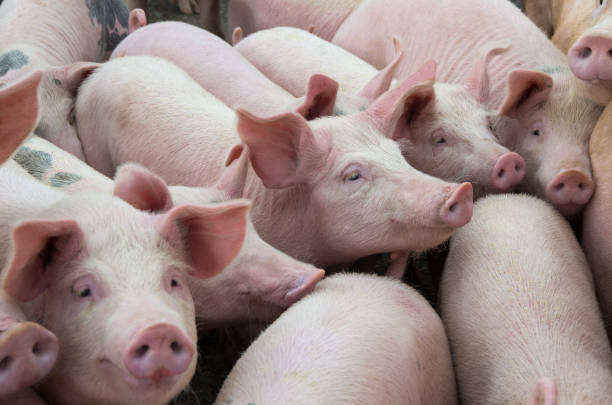Pig farming is a lucrative business opportunity in Ghana. With the growing demand for pork and other pig products, starting a piggery can be a profitable venture. This article provides a step-by-step guide on how to start a successful pig farming business in Ghana.
The pig farming industry in Ghana is still relatively small compared to the potential it holds. Pork consumption in Ghana has risen steadily over the years as the population grows and the economy develops. This presents a huge opportunity for aspiring pig farmers to tap into the increasing demand and make good money rearing pigs.
Pig farming requires substantial capital investment and proper planning. However, with hard work and persistence, you can build a thriving piggery business. This guide takes you through the basics of starting and running a pig farm in Ghana successfully.
Steps to Start a Pig Farming Business in Ghana
Step 1: Conduct Market Research
Before diving into setting up a pig farm, it\’s important to do thorough market research. This will help you understand the industry, demand and supply dynamics, profitability potential, and risks involved. Here are a few things to analyze:
- The current production level of pork and other pig products in Ghana and growth trends. This will indicate if demand is being adequately met or if there are shortfalls you can fill.
- Consumer preferences, cultural considerations, and meat purchasing patterns in your target market. This will help shape your production plan.
- The number of existing commercial pig farms in your preferred location. This will gauge competition levels.
- Prices of live pigs and pig products like pork, ham, bacon, sausages. Study price trends over the past few years.
- Import and export data for pig products to see if there are opportunities to export.
- Production costs involved in pig farming in Ghana including feed, labor, utilities, medication, etc.
- Policies and regulations that apply to piggery businesses.
Step 2: Choose a Suitable Location
An ideal location is critical for any livestock farming venture. For a pig farm, consider these factors when choosing a location:
- Proximity to target markets like slaughterhouses, pork dealers, high-end hotels and restaurants. This minimizes transportation costs.
- Availability of cheap land, preferably 5-10 acres to allow for expansion. Have the land title deed ready.
- Peaceful area away from residential zones to avoid noise complaints.
- Good road access and connectivity to transport pigs, feed, workers, etc.
- Closeness to raw material suppliers like feed merchants. This reduces costs.
- Access to a reliable water source like a borehole or river. Pigs drink large volumes of water.
- Cool climate with temperatures between 22°C to 30°C. Extreme heat stresses pigs.
- Electricity supply to power equipment and lighting.
Step 3: Choose a Pig Breed
There are many breeds suited for commercial pig farming in Ghana. Some popular options include:
- Large White: Originating from Yorkshire, these pigs are hardy, fast growing and have good feed conversion efficiency. They are suited for pork production.
- Landrace: A Danish breed that produces lean meat and large litters of 10-12 piglets. Withstands tropical climates well.
- Duroc: Known for rapid weight gains, survival ability and quality meat, Durocs are ideal for small and large scale farming.
- Hampshire: Produces flavorful meat and gains weight quickly with minimal fat. Docile temperament.
- Saddlebacks: A black and white British breed resistant to diseases. Produces tasty pork and bacon.
Choose breeds based on productivity, survival rates, feed efficiency and tolerance to local conditions. Import breeding stock from reputable suppliers.
Step 4: Develop Housing and Fencing
Pigs require housing for shelter, feeding, breeding and protection from predators. The main types of pig housing include:
- Open housing: Simple structures with a roof but no walls e.g. A-frame shelters. Good for warm climates but provide minimal protection. Cheap to build.
- Closed housing: Complete buildings like modified sheds or barns. Controls temperature and ventilation. More expensive but gives better protection.
Key factors to consider when constructing pig housing include:
- Use locally available materials like timber, metal sheets, concrete etc. Keep costs low.
- Allow at least 15-20 square feet per pig. Provide enough space for movement.
- Proper ventilation using wires, ducts and windows prevents heat buildup.
- Raised floors keep pigs clean and dry. Use slatted concrete floors.
- Sturdy feeders and drinkers specific to pig\’s height and size.
- Design housing to enable easy cleaning using water, disinfectants etc.
Additionally, install strong perimeter fencing around the piggery using barbed wire, electrified wiring or chain link. This keeps pigs securely contained.
Step 5: Buy Quality Stock
To start your herd, buy weaned piglets aged 8-10 weeks from reputable breeders. Female piglets or gilts are a better investment since they grow into breeding sows. Buy from farms with health management protocols to get disease-free stock.
Alternatively, buy healthy young boars and pregnant sows to kickstart breeding. Select stock based on qualities like:
- Health and vaccination records
- No physical defects
- From reputable breeding lines
- Conformed to breed standards
- Castrated boars if needed
Quarantine new stock for at least 2 weeks before introducing to your herd. Provide proper housing, feed, medication and biosecurity in quarantine.
Step 6: Feed and Nutrition
Feed makes up about 75% of the cost of pig farming. Pigs need a balanced, nutritious diet for optimal growth and health. Work with an animal nutritionist to formulate suitable feed rations using ingredients like:
- Grains: Corn, soybeans, sorghum, wheat bran
- Forage: Hay, silage, root vegetables
- Supplements: Wheat pollard, bone meal, salt, enzymes
- Vitamins and minerals: For bone, teeth and body development
Provide the right feed ratios at each stage e.g. starter rations for weaned pigs, grower feed for fatteners etc. Supply fresh, clean drinking water at all times.
Step 7: Health and Husbandry
Follow strict biosecurity protocols on your pig farm by:
- Controlling access to the farm
- Disinfecting housing between batches
- Properly disposing dead pigs
- Keeping sick and healthy pigs separate
- Having dedicated clothing and footwear
Additionally:
- Maintain high hygiene and sanitation standards in housing, feeders etc.
- Establish an isolation pen for sick pigs.
- Vaccinate pigs against common diseases like foot and mouth.
- Deworm, disinfect and dip pigs regularly.
- Promptly treat any injuries, sores, infections etc.
- Schedule breeding carefully to avoid inbreeding.
Step 8: Waste Management
Pig waste can pollute the environment if not properly handled. Safely manage manure and other waste by:
- Using slatted floors so urine and feces fall through.
- Collecting manure in lagoons for composting.
- Spreading manure on fields as organic fertilizer.
- Avoiding water pollution through proper drainage channels.
- Composting dead pigs if not selling to rendering plants.
Adhere to environmental regulations when disposing pig waste.
Step 9: Getting Licenses and Permits
To formally register your pig farming business in Ghana, you\’ll need:
- Business registration certificate from the Registrar General\’s Department
- Operating permit from the Metropolitan, Municipal or District Assembly
- Environmental permit from the Environmental Protection Agency (EPA)
- Import licenses if bringing in breeding stock, feeds etc.
Ensure your piggery layout and structures meet required standards. Renew all permits accordingly.
Step 10: Hiring Staff
Pig farming involves intensive labor for tasks like feeding, cleaning barns, health management etc. As the business expands, hire qualified staff including:
- Farm manager: Oversees day-to-day operations. Needs livestock experience.
- Feeders: Provide feed and water to pigs daily.
- Pork handlers: Load pigs for transport to slaughter.
- Veterinarian: Provides healthcare to pigs. Part-time or on-call basis.
- Field officers: Manage crops grown for making own pig feed.
Train staff thoroughly on biosecurity, herd management, administering medication etc. Offer protective wear.
Step 11: Record Keeping
Maintaining detailed records is key for monitoring performance and progress. Keep records of:
- Pig inventory including new births, sales, deaths etc.
- Feed intake per pen or pig
- Weight gain tracking
- Health treatments, vaccines given etc.
- Feed formulations
- Sales records
- Performance of breeding stock
- Production costs and profitability
Use the records to evaluate productivity and make improvements. Digital record keeping using farm software boosts efficiency.
Step 12: Managing Finances
Pig farming requires considerable capital investment. Typical costs involved include:
- Land purchase and fencing
- Housing and equipment
- Initial breeding stock
- Animal feed
- Veterinary care and vaccines
- Labor
- Utilities like electricity and water
- Licenses and permits
Prepare financial projections detailing estimated income and expenses. Have working capital available to cover day-to-day operations. Open a separate bank account and keep accurate financial records. Consider getting an agricultural loan. Leverage pig farming grants if available.
Conclusion
Starting a profitable pig farming venture takes careful planning, sizable investment and consistent hard work. Do thorough research and have passion for livestock farming. Seek guidance from existing pig farmers, veterinarians and your local agricultural extension office. With sound husbandry practices and business management, your piggery can succeed and provide good income for years to come. Be diligent, patient and willing to learn and grow.

